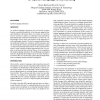Free Online Productivity Tools
i2Speak
i2Symbol
i2OCR
iTex2Img
iWeb2Print
iWeb2Shot
i2Type
iPdf2Split
iPdf2Merge
i2Bopomofo
i2Arabic
i2Style
i2Image
i2PDF
iLatex2Rtf
Sci2ools
CHI
1995
ACM
1995
ACM
Integrating multiple cues for spoken language understanding
As spoken language interfaces for real-world systems become a practical possibility, it has become apparent that such interfaces will need to draw on a variety of cues from diverse sources to achieve a robustness and naturalness approaching that of human performance [1]. However, our knowledge of how these cues behave in the aggregate is still tantalizingly sketchy. We lack a strong theoretical basis for predicting which cues will prove useful in practice and for specifying how these cues should be combined to signal or cancel out potential interpretations of the communicative signal. In the research program summarized here, we propose to develop and test an initial theory of cue integration for spoken language interfaces. By establishing a principled basis for integrating knowledge sources for such interfaces, we believe that we can develop systems that perform better from a computer-human interaction standpoint.
CHI 1995 | Computer-human Interaction Standpoint | Human Computer Interaction | Spoken Language Interfaces | Strong Theoretical Basis |
| Added | 25 Aug 2010 |
| Updated | 25 Aug 2010 |
| Type | Conference |
| Year | 1995 |
| Where | CHI |
| Authors | Karen Ward, David G. Novick |
Comments (0)

